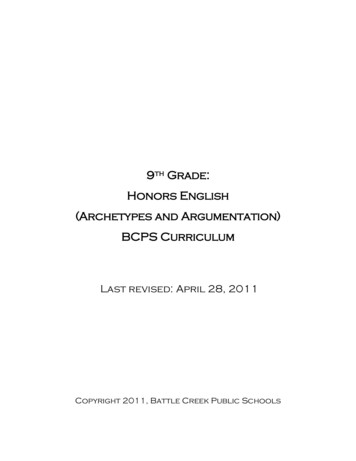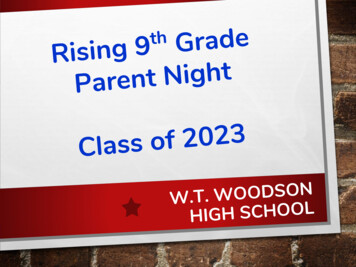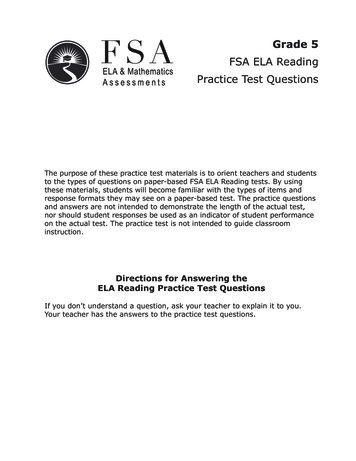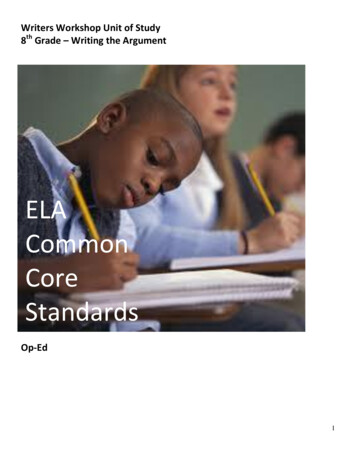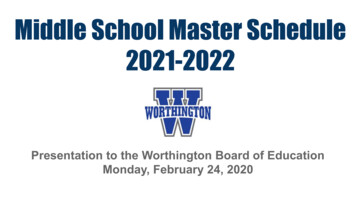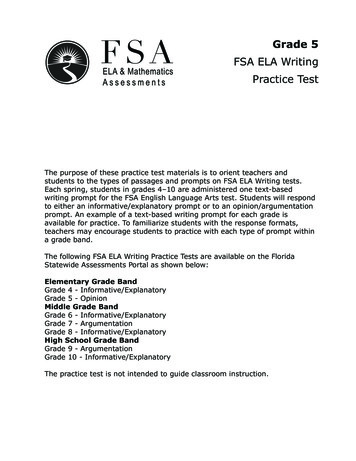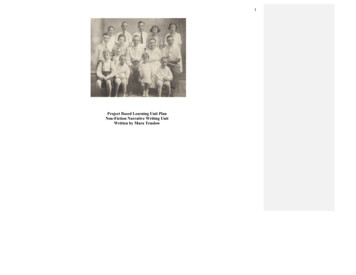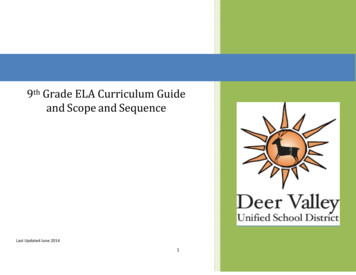
Transcription
9th Grade ELA Curriculum Guideand Scope and SequenceLast Updated June 20141
Table of ContentsProtected Novel List for Grades 6-12 .3Year-Long Curriculum Preview . 4How to Read the Curriculum Guide . .5Curriculum Guide Collection 1 . 6Collection 2 12Collection 3 14Collection 4 23Collection 5 28Collection 6 34CCI Cycle Suggestions 39Arizona State College and Career Ready Anchor Standards .41Depth of Knowledge (DOK) Explanation and Chart .43Writing Rubric and Conversion Chart .44District Test Standards and Need to Know Vocabulary .462
ELA 6-12 Protected Novel Listth6 GradeBud, Not BuddyThe Lightning ThiefThe GiverLove That DogThe Dark is RisingDragon WingsSAGE/RenaissanceTeacher DiscretionChasing Lincoln’sKillerAdv. 7 Grade L.A.The Hobbit,The Story of my Life:The Helen KellerStory, I am theCheese, TheOutsidersthth7 Grade*Sorry, WrongNumberUgliesThe House onMango StreetNothing But theTruthGracelingEnder’s Gamethth8 Grade*The Diary ofAnne FrankThe OutsidersThe Hunger GamesParallel JourneysMonsterWhirligigAdv. 8 Grade L.A.Fahrenheit 451,Book Thief,Animal Farm, AMidsummer Night’sDreamTo Kill a MockingbirdThe PearlThe Bean TreesThe HobbitThe OdysseyELA 1-2 HonorsGreat Expectations,Wuthering HeightsA Long Way GoneELA 3-4 HonorsBrave New World,Things Fall Apart,1984th9 Grade*Romeo andJulietth10 Grade*MacbethNightAnthemAnimal FarmLord of the FliesFlowers forAlgernonthThe Things They CarriedThe Great GatsbyOf Mice and MenInto the WildA Separate PeaceA Raisin in the SunJR APTeacher ver's TravelsBeowulfSR APTeacher Discretion11 Grade*The Crucible12 Grade*Hamlet*Dramas from Collections Textbook3
ELA 1Fall Semester PreviewSuggested Writing Focus: Argumentative and Narrative WritingCollection 3: The Bonds Between UsSuggested Time Frame: 5-10 WeeksAnchor Texts: “When Mr. Pirzada Came toDine” by Jhumpa Lahiri and “Monkey See,Monkey Do, Monkey Connect” by Frans deWaalProtected Novels: To Kill a Mockingbirdby Harper Lee, *Great Expectations by CharlesDickens, *Wuthering Heights by Emily BronteCollection 2: The Struggle forFreedomCollection 1: Finding CommonGroundSuggested Time Frame: 4-6 WeeksAnchor Texts: “I Have a Dream” by MartinLuther King, Jr.; from Nobody Turn Me Around:A History of the 1963 March on Washington”by Charles EuchnerProtected Novels: n/aSuggested Time Frame: 5-10 WeeksAnchor Texts: “A Quilt of a Country”by Anna Qundlen and “Once Upon a Time”by Nadine GordimerProtected Novels: To Kill a Mockingbird byHarper Lee, *Great Expectations, by CharlesDickens, *Wuthering Heights by Emily Bronte* Honors level* Honors levelELA 2 Spring Semester PreviewSuggested Writing Focus: Literary Analysis WritingCollection 4: Sweet SorrowSuggested Time Frame: 6-8 WeeksAnchor Texts: Romeo and Julietby William ShakespeareProtected Novels: Romeo and Julietby William ShakespeareCollection 5: A Matter of Life or DeathCollection 6: Heroes and QuestsSuggested Time Frame: 3-6 WeeksAnchor Texts: Night by Elie Wiesel and “TheEnd and the Beginning”by Wislawa SzymborskaProtected Novels: The Pearl by John SteinbeckSuggested Time Frame: 3-6 WeeksAnchor Texts: from the Odyssey by HomerProtected Novels: The Odyssey by HomerThe Bean Trees by Barbara KingsolverNote: All anchor texts and at least one novel or play from the protected list must be taught each semester.All content can be found in the Collections textbook or on my.hrw.com.4
How to Read the Curriculum Document GuideUnit: Name of the CollectionSuggested Time Frame: (included to help with planning parameters)SemesterDistrict Assessment Dates:Academic Vocabulary: Vocabulary needed to understand the unit (listed at the beginning of each unit in text).Reading LiteratureReading InformationalAnchor Text: this comes directly from the textbook; required readingLexile:Standards: all standards associated with the text and performance tasksCritical Vocabulary: words that are not part of the day-to-day vocabulary from thepieceNeed to Know Vocabulary: words that are important to know to analyze the text(found in the teacher edition and Analyzing the Text section)Page:Text: this comes directly from the textbookLexile:Standards: all standards associated with the text and performance tasksCritical Vocabulary: words that are not part of the day-to-day vocabulary from the pieceNeed to Know Vocabulary: words that are important to know to analyze the text (found inthe teacher edition and Analyzing the Text section)Page:See Above: These texts found in the Close Reader (CR) and teacher edition (TE)See Above: These texts found only in the Close Reader (CR)Texts found in Close Reader (CR)Possible Extended TextsVarious short stories and longer pieces (novels/plays) that can connect to the unit (depending on campus availability). Each semester one protected novel/play must be read.Common Core Assessment ConnectionsWriting units that focus on argumentative, informative, and literary analysis writing.Instructions for finding online supplemental materials.Additional ResourcesEssential QuestionsEssential questions are big ideas formulated as questions that encourage students to research, inquire, and think critically.Text TitleStudent Friendly ObjectivesTSW: (The student will) ------Comes directly from the textbook.DOK1 – RecallPerformance Task and Depth of KnowledgeDOK2 – Skill ConceptDOK 3 – Strategic ThinkingText TitlePerformance Tasks come directlyfrom the text/ suggested ideas.Standards and page numbersincluded.Text TitleAt the end of various texts, there is an optional grammar activity teachers may choose to use.Please note: You do not need tocomplete every performance task onthe list.Performance Tasks are assessmentsand writing tasks.Optional Language and Style Resources5DOK 4 – Extended ThinkingSee the DOK page in this documentfor more information.Standards AddressedPage number
Unit 3: Collection 1: Finding Common GroundSuggested Time Frame: 6 weeksFall SemesterExplanatory Assessment Dates: January 12-February 3, 2015Academic Vocabulary: enforce, entity, internal, presume, resolveReading LiteratureAnchor Text: short story “Once Upon a Time” by Nadine GordimerLexile: 1390Standards: RL.1, RL.2, RL.4, RL.5, RL.6, W.3, L.1b, L.3, L.4cCritical Vocabulary: distend, intention, audacious, intrusion, serrateNeed to Know Vocabulary: identify, connect, infer, evaluate, draw conclusions,theme, symbol, structure, inferencesPage: 11Text: photo essay “The Views of the Wall”Poem “The Vietnam Wall” by Alberto RiosLexile: n/aStandards: RL.1, RL.2, RL.4, RL.5, RL.7Critical Vocabulary: n/aNeed to Know Vocabulary: analyze, simile, central idea, artistic mediumsPage: 33Text: short story “Night Calls” by Lisa FugardLexile: 1110Standards: RL.1Critical Vocabulary: opulent, lauding, tremulousNeed to Know Vocabulary: cite, narrator, inferencePage: CR 9, TE 20cReading InformationalAnchor Text: argument “A Quilt of a Country” by Anna QuindlenLexile: 1260Standards: RI.1, RI.4, RI.5, RI.6, RI.8, W.1, W.1a, W.1b, L.1b, L.4bCritical Vocabulary: discordant, pluralistic, interwoven, diversity theme, symbol, claim,counter-argumentNeed to Know Vocabulary: summarize, interpret, evaluate, analyze, delineate, theme,symbol, claim, counter-argumentPage: 3Text: essay from “Rituals of Memory” by Kimberly M. BlaeserLexile: 1380Standards: RI.1, RI.2, RI.4, RI.6, SL.1, L.5bCritical Vocabulary: innate, foremost, immerse, nullify, tangibleNeed to Know Vocabulary: analyze, infer, identify, central idea, repetitionPage: 21Text: speech “The Gettysburg Address” by Abraham LincolnLexile: 1170Standards: RI.1, RI.6, RI.9, SL.1d, SL.6, L.1a, L.4aCritical Vocabulary: conceive, detract, resolve, parishNeed to Know Vocabulary: analyze, infer, draw conclusions, parallel structure, themePage: 27Texts found in Close Reader (CR)Text: blog “Making the Future Better, Together” by Eboo PatelLexile: 1170Standards: RI.1Critical Vocabulary: demean, cynicalNeed to Know Vocabulary: cite, point of view, explicit, claimPage: CR 3, TE 10bText: speech “Oklahoma Bombing Memorial Address” by Bill Clinton6
Lexile: 1060Standards: RI.1Critical Vocabulary: purge, admonishedNeed to Know Vocabulary: cite, purpose, inference, symbolize, parallelismPage: CR 19, 32bPossible Extended TextsTo Kill a Mockingbird by Harper Lee (protected novel)Bless Me, Ultima by Rudolfo AnayaThe Bean Trees by Barbara Kingsolver (protected novel)Common Core Assessment (CCA) ConnectionsUnit 3: Literary Analysis Practice (Page: CCA 68-95)Unit 4: Task 3 – Literary Analysis (Page: CCA 125)Additional Resourceshttp://my.hrw.com7
Essential QuestionsHow does an individual relate to society?How do our life experiences impact our interactions with others?“Once Upon a Time”“The Views of the Wall”“Night Calls”“A Quilt of a Country”“Rituals of Memory”“The Gettysburg Address”“Making the Future Better, Together”“Oklahoma Bombing Memorial Address”Student Friendly ObjectivesTSW analyze the author’s choices concerning text structure; determine and support inferences about the theme;cite textual evidence to support analysis of the textTSW analyze the representation of a subject in two different mediumsTSW cite evidence to support inferences in a textTSW analyze and evaluate an author’s claim and delineate and evaluate an argumentTSW determine a central idea and analyze its development over the course of a textTSW analyze an author’s purpose and the use of rhetorical devices in a seminal U.S. documentTSW cite evidence to support inferences in a textTSW cite evidence to support inferences in a text8
TitleDOK1 – RecallPerformance Task and Depth of KnowledgeDOK2 – Skill ConceptDOK 3 – StrategicThinking“Once Upon a Time”“The Views of the Wall”Media Activity: Compare theexpressions of ideas in twomediumsRL.7Page 36Media Activity: Interview anddiscuss war memorialsRL.7Page 36“Night Calls”“A Quilt of a Country”“Rituals of Memory”“The Gettysburg Address”Speaking Activity: Reflect anddiscuss how two possessionsare importantSL.1Page 25Speaking Activity: Work ingroups to prepare an oralpresentation of the GettysburgAddressSL.6Page 309Writing Activity: Respond to aquestion citing textualevidenceRL.1Page 20hWriting Activity: Write tosupport a claim about apositive aspect of your schoolor communityW.1a-bPage 8DOK 4 – Extended ThinkingSpeaking Activity: Create and performan original modern fairy taleW.3Page 18
Writing Activity: Respond to aquestion citing textualevidenceRL.1Page 10fWriting Activity: Respond to aquestion citing textualevidenceRL.1Page 32e“Making the Future Better,Together”“Oklahoma BombingMemorial Address”Full CollectionFull Collection10Speaking Activity: Present a speechwhich incorporates ideas from thiscollectionSL.4, SL.6Page 37Writing Activity: Write an analyticalessay which incorporates ideas from thiscollectionW.2a-f, W.4, W.5, W.9a-bPage 41
Optional Language and Style Resources“Once Upon a Time”“The Views of the Wall”“Night Calls”“A Quilt of a Country”“Rituals of Memory”“The Gettysburg Address”“Making the Future Better, Together”“Oklahoma Bombing Memorial Address”Prepositional phrasesn/an/aNoun clausesn/aParallel structuren/an/a11L.1b, L.3Page 20L.1bPage 10L.1aPage 32
Unit 2: Collection 2: The Struggle for FreedomSuggested Time Frame: 6 weeksFall SemesterArgumentative Assessment Dates: November 3-December 11, 2014Academic Vocabulary: decline, enable, impose, integrate, revealReading LiteratureText: short story “The Censors” by Luisa ValenzuelaLexile: 1200Standards: RL.1, RL.2, RL3, RL.4, RL.5, RL.6, W.3, W.9, L.1, L.2a-b, L.4bCritical Vocabulary: staidness, negligence, subversiveNeed to Know Vocabulary: infer, analyze, cite, compare, interpretPage: 89Reading InformationalAnchor Text: speech “I Have a Dream” by Martin Luther King, Jr.Lexile: 1120Standards: RI.1, RI.2, RI.3, RI.4, RI.5, RI.6, RI.7, RI.9, W.2, L.1aCritical Vocabulary: default, desolate, degenerate, inextricably, redemptiveNeed to Know Vocabulary: infer, analyze, interpret, evaluate, allusion, claim, argumentPage: 47Anchor Text: history writing from Nobody Turn me Around: A People’s History of the1963 March on Washington by Charles EuchnerVideo AMERICA The Story of Us: March on WashingtonLexile: 1030Standards: RI.1, RI.2, RI.3, RI.4, RI.5, RI.6, RI.7, W.3, W.3d, L.4cCritical Vocabulary: cadence, parallel, invocation, civic, revile, expanse, exhort, invokeNeed to Know Vocabulary: analyze, infer, evaluatePage: 55Text: diary from Cairo: My City, Our Revolution by Ahdaf SoueifLexile: 990Standards: RI.1, RI.3, RI.4, W.2b, W.2e, W.5, W.7, W.8, SL.4, L.1b, L.4c, L.4d, L.6Critical Vocabulary: opaque, reclaim, prism, intermittent, momentousNeed to Know Vocabulary: analyze, cite, infer, interpretPage: 73Text: memoir from Reading Lolita in Tehran by Azar Nafisigraphic novel from Persepolis 2 by Marjane SatrapiLexile: 1150Standards: RI.1, RI.2, RI.6, RI.7, W.3, W.6, L.3, L.4, L.5bCritical Vocabulary: segregate, allocate, irrelevant, convertNeed to Know Vocabulary: interpret, critique, infer, analyze, synthesize, memoir,symbolizePage: 8112
Texts found in Close Reader (CR)Text: short story “The Prisoner Who Wore Glasses” by Bessie HeadLexile: 970Standards: RL.1Critical Vocabulary: bedlam, pivotNeed to Know Vocabulary: cite, analyze, foreshadow, apartheidPage: CR 29, TE 96bText: speech by Robert F. Kennedy “A Eulogy for Dr. Martin Luther King, Jr.”Lexile: 1290Standards: RI.1Critical Vocabulary: n/aNeed to Know Vocabulary: cite, parallelism, rhetoric, eulogyPage: CR 25, TE 72bPossible Extended TextsCommon Core Assessment (CCA) ConnectionsUnit 1: Argumentative Essay (Page: CCA 2)Task 1 (Page: CCA 99)Task 2: Informative Essay (Page CCA: 111)Additional Resources“Conducting Research” page R8-9 (From textbook)“Collection 2 Performance Task: Writing an Argument” page 97 (From Textbook)“MLA Citation Guidelines” page R10-11 (From Textbook)“Reading Arguments” page R16-21Owl at Purdue (www.owl.english.purdue.edu)Son of Citation Machine (www.citationmachine.net)13
Essential QuestionsWhat makes a source reliable or credible?Why do we universally desire to be free?“The Censors”“The Prisoner Who Wore Glasses”“I Have a Dream”Nobody Turn me Around From Cairo: My City, Our RevolutionFrom Reading Lolita in TehranFrom Persepolis 2“A Eulogy for Dr. Martin Luther King, Jr.”Student Friendly ObjectivesTSW analyze a writer’s point of view and cultural background, and also analyze an author’s choices about style and structureTSW cite textual evidence to support inferences from the textTSW analyze a seminal U.S. document and the impact of its rhetoricTSW analyze connections between ideas and events and analyze accounts in different mediumsTSW analyze how an author unfolds events in a diary and analyze the impact of word choice on toneTSW determine author’s point of view and analyze accounts in different mediumsTSW cite textual evidence to support inferences from the text14
TitleDOK1 – RecallPerformance Task and Depth of KnowledgeDOK2 – Skill ConceptDOK 3 – StrategicThinkingWriting Activity: Write a letterfrom the point of view of acharacterRL.1, W.9, L.1Page 94Writing Activity: Respond to aquestion citing textualevidence RL.1Page 96gWriting Activity: Write ananalysis to compare the ideasof two speechesW.2Page 53Writing Activity: Write anaccount to explain a historicaleventW.3Page 72Research Activity: Researchand write a brief report on theEgyptian Revolution of 2011SL4, W.2b, W.7, W.8,Page 78Media Activity: Create agraphic novelRI.7, W.3, W.6Page 86Writing Activity: Respond to aquestion citing textualevidence RL.1Page 72e“The Censors”“The Prisoner Who WoreGlasses”“I Have a Dream”Nobody Turn me Around From Cairo: My City, OurRevolutionFrom Reading Lolita in TehranFrom Persepolis 2“A Eulogy for Dr. MartinLuther King, Jr.”Full Collection15DOK 4 – Extended ThinkingWriting Activity: Write an argumentW.1a-e, W.4, W.5, W.9a-bPage 97
“The Censors”“The Prisoner Who Wore Glasses”“I Have a Dream”Nobody Turn me Around From Cairo: My City, Our RevolutionFrom Reading Lolita in TehranFrom Persepolis 2“A Eulogy for Dr. Martin Luther King, Jr.”Optional Language and Style ResourcesColons and semicolonsn/aRepetition and parallelismn/aNoun phrasesRhetorical questionsn/a16L.2a-bPage 96L.1aPage 54L.1bL.3Page 80Page 88
Unit 1: Collection 3: The Bonds Between UsSuggested Time Frame: 6 weeksFall SemesterNarrative Assessment Dates: September 26-October 17, 2014Academic Vocabulary: capacity, confer, emerge, generate, traceReading InformationalReading LiteratureAnchor Text: short story “When Mr. Pirzada Came to Dine”by Jhumpa LahiriLexile: 1170Standards: RL.1, RL.2, RL.3Critical Vocabulary: autonomy, compatriot, constitute, impeccably, imperceptible,succession, assail, reiteration, concede, commemorateNeed to Know Vocabulary: analyze, infer, interpret, citePage: 103Text: short story “The Grasshopper and the Bell Cricket”by Yasunari KawabataLexile: 1060Standards: RL.1, RL.2, RL.4, RL.6Critical Vocabulary: emanate, sheepish, discernible, theme, inferences,characters, symbol, tone, capacity, emerge, lozenge, loiterNeed to Know Vocabulary: interpret, infer, analyze, cite, comparePage: 133Text: poem “At Dusk” by Natasha TretheweyLexile: n/aStandards: RL.1, RL.4Critical Vocabulary: n/aNeed to Know Vocabulary: interpret, infer, analyze, generate, trace, imagery,tone, moodPage: 147Anchor Text: science writing “Monkey See, Monkey Do, Monkey Connect” by Frans deWaalLexile: 1160Standards: RI.1, RI.4, RI.5, RI.8Critical Vocabulary: Empathy, synchronization, contagion, cognition, implicationNeed to Know Vocabulary: analyze, cite, interpret, identify, infer, support, drawconclusions, allusion, tone, claimPage: 123Text: informational text “With Friends Like These” by Dorothy RoweLexile: 1070Standards: RI.1, RI.3, RI.4Critical Vocabulary: validate, derive, assessNeed to Know Vocabulary: infer, connect, analyze, cite, tone, transitions, repetitionPage: 141Text: Public Service Announcement (Video) “Count on Us”from Corporation for National and Community ServiceLexile: n/aStandards: RI.1, RI.2, RI.5, RI.6Critical Vocabulary: n/aNeed to Know Vocabulary: Draw conclusions, analyze, identifyPage: 151Texts Found in Close Reader (CR)Text: short story “And of Clay are we Created” by Isabel AllendeLexile: 1220Standards: RL.1, RL.4Critical Vocabulary: Subterranean, cataclysm, presentiment, equanimity, fictive,ingenuity, commiserate, bureaucratic, visceralNeed to Know Vocabulary: cite, summarize, inference, point of view, themePage: CR 39, TE 122bText: science writing From Animals in Translationby Temple Grandin and Catherine JohnsonLexile: 950Standards: RI.1, RI.4Critical Vocabulary: n/aNeed to Know Vocabulary: restate, claim, cite, analogyPage: CR 53, TE 132b17
Possible Extended TextsTo Kill a Mockingbird by Harper Lee (protected novel)*Great Expectations by Charles Dickens (protected novel)*Wuthering Heights by Emily Bronte (protected novel)*Honors level choicesCommon Core Assessment (CCA) ConnectionsAdditional Resourcesmy.hrw.comAdditional short stories to consider:“Thank you, Ma’am”“The Necklace”“The Gift of the Magi”“Black Boy”“When I Lay my Burden Down”“The Loophole of Retreat”“Sound of Thunder”“The Scarlet Ibis”“Harrison Bergeron”18
Essential QuestionsWhat links us to family, friends, and community?What characteristics set us apart as individuals?“When Mr. Pirzada Came to Dine”“The Grasshopper and the Bell Cricket”“At Dusk”“And of Clay are we Created”“Monkey See, Monkey Do, MonkeyConnect”“With Friends Like These”“Count on Us”From Animals in TranslationStudent Friendly ObjectivesTSW cite textual evidence to analyze character and theme in a short story and to support inferences about themesTSW analyze the impact of cultural background on point of view and also analyze the impact of word choice on toneTSW interpret figurative languageTSW cite strong and thorough textual evidence to support what the text says explicitly, as well as inferences drawn from the textTSW delineate and evaluate an author’s claims and determine the technical meanings of words used in the textTSW analyze how an author unfolds a series of ideas in an informational textTSW analyze the purpose and development of ideas in a public service announcementTSW cite strong and thorough textual evidence to support what the text says explicitly, as well as inferences drawn from the text19
TitleDOK1 – RecallPerformance Task and Depth of KnowledgeDOK2 – Skill ConceptDOK 3 – StrategicThinkingWriting Activity: Write a letterfrom a character’s point ofview W.3Page 120Writing Activity: Write a letterto a characterW.3Page 138“When Mr. Pirzada Came toDine”“The Grasshopper and theBell Cricket”“At Dusk”Speaking Activity:Reading or reciting a piece ofpoetry with focus on pitch,tempo, and volumeRL.4, L.5aPage 150Writing Activity: Respond to aquestion citing textualevidenceRL.1Page 122jSpeaking Activity: Debate aPoint of View and supportposition with evidenceSL.1d, SL.3Page 130“And of Clay are we Created”“Monkey See, Monkey Do,Monkey Connect”“With Friends Like These”Speaking Activity: Discussion toagree or disagree with pointsmade in the textSL.1Page 144Media Activity: Create a Public ServiceAnnouncementW.6Page 152“Count on Us”From Animals in TranslationDOK 4 – Extended Thinking20Writing Activity: Respond to aquestion citing textual
evidenceRL.1Page 132eWriting Activity: Write a fictionalnarrative essayW.3a-e, W.4, W.5, W.9a-bPage 153Media Activity: Create a group multimedia presentationW.6, SL.1a-d, SL.2, SL.4, SL.5, SL.6Page 157Full CollectionFull Collection21
“When Mr. Pirzada Came to Dine”“The Grasshopper and the Bell Cricket”“At Dusk”“And of Clay are we Created”“Monkey See, Monkey Do, Monkey Connect”“With Friends Like These”“Count on Us”From Animals in TranslationOptional Language and Style ResourcesAdverbial clausesUsing verb phrasesInterpreting figurative languagen/aColonsAdjective and adverb phrasesn/an/a22L.1bL.1bL.5aPage 122Page 140Page 149L.2bL.1bPage 132Page 146
Collection 4: Sweet SorrowSuggested Time Frame: 6 weeksSpring SemesterLiterary Analysis Assessment Dates: January 12-February 3, 2015Academic Vocabulary: attribute, commit, expose, initiate, underlieReading LiteratureAnchor Text: drama Romeo and Juliet by William ShakespeareLexile: N/AStandards: RL.1, RL.2, RL.3, RL.4, RL.5Critical Vocabulary: n/aNeed to Know Vocabulary: puns, dramatic irony, hyperbole, soliloquy, tragedy,motif, foreshadow, situational irony, tragedy, theme, point of view, complexcharacter, parallel structure, protagonist, antagonist, foil, comic relief, allusion,blank verse, iambic pentameter, motivation, figurative language, metaphor,conflict, oxymoron, chorus, prologue, motif, idioms, syntax, interpret, analyze,predict infer, evaluate, cite comparePage: 177Text: poem/video “My Shakespeare” by Kate TempestLexile: n/aStandards: RL.1, RL.2, RL.4, RL.7, RL.9Critical Vocabulary: n/aNeed to Know Vocabulary: infer, cite, analyze, figurative language, alliteration,rhyme, sound, devices, theme, cliché, adage, idiomPage: 173Text: myth “Pyramus and Thisbe” by OvidLexile: n/aStandards: RL.1-5, RL.9Critical Vocabulary: n/aNeed to Know Vocabulary: cite, connect, compare, proverb, foreshadow, imagery,denotation, connotationPage: 283Reading InformationalText: essay From “Love’s Vocabulary” by Diane AckermanLexile: 1020Standards: RI.1-5Critical Vocabulary: intangible, guise, increment, supple, gradationNeed to Know Vocabulary: infer, evaluate, cite, analyze, interpret, tone, transitions,repetitionPage: 16323
Text: short story “Duty” by Pamela Rafael BerkmanLexile: 940Standards: RL.2, RL.3, RL.4, RL.5, RL.7, RL.9Critical Vocabulary: bereaved, afflict, succumb, delude, repulseNeed to Know Vocabulary: Infer, identify, analyze, interpret, compare, mood,point of viewPage: 289Texts Found in Close Reader (CR)Text: from The Tragedy of Romeo and Juliet – Prologue Act II, scene iiby William ShakespeareLexile: n/aStandards: RL.1Critical Vocabulary: mutinyNeed to Know Vocabulary: cite, theme, soliloquyPage: CR 63, TE 282bPossible Extended TextsRomeo and Juliet by William Shakespeare (protected novel)Common Core Assessment (CCA) ConnectionsUnit 3 – Literary AnalysisUnit 4 – Task 3: Literary Analysis24
Essential QuestionsWhy do modern audiences still relate to Shakespeare’s work?What is the nature of love?Romeo and Juliet“My Shakespeare”“Pyramus and Thisbe”From “Love’s Vocabulary”“Duty”From The Tragedy of Romeo and Juliet –Prologue Act II, scene iiStudent Friendly ObjectivesTSW analyze character motivations and parallel plotsTSW analyze how a modern artist draws on and transforms source material for a new artistic expressionTSW analyze source materialTSW analyze ideas presented in an essay and determine word meaningsTSW analyze how an author draws on and transforms source material and how an author’s choice of point of view createsdesired effectsTSW cite evidence from the text to support inferences25
TitleDOK1 – RecallPerformance Task and Depth of KnowledgeDOK2 – Skill ConceptDOK 3 – StrategicThinkingSpeaking Activity (Act I):Identify passages that expresslove or hateSL.1Page 206Speaking & Writing Activity(Act IV): Perform a dramaticreading of a scene and write aletter that explains charactermotivationsW.10Page 165Romeo and Juliet“My Shakespeare”“Pyramus and Thisbe”From “Love’s Vocabulary”“Duty”Media Activity: Use technologyto reflect on a poemRL.9Page 176Writing Activity: Compare“Pyramus and Thisbe” toRomeo and JulietW.9aPage 288Speaking Activity: Discuss thensummarize the main idea of thetextW.10, SL.1Page 17026Speaking Activity (Act II):Debate motivations from acharacter’s point of viewSL.1Page 227Writing Activity (Act III):Explore the parallel feelings ofdespair by writing a journalentry from the point of view ofa characterW.10Page 252Writing Activity (Act V):Write a eulogy for a characterW.3Page 280Writing Activity: Write ajournal entry from the point ofDOK 4 – Extended Thinking
view of a characterW.3Page 298Writing Activity: Write aresponse citing textualevidence a supportRL.1Page 282iFrom The Tragedy of Romeoand Juliet – Prologue Act II,scene iiRomeo and Juliet“My Shakespeare”“Pyramus and Thisbe”From “Love’s Vocabulary”“Duty”From The Tragedy of Romeo and Juliet –Prologue Act II, scene iiOptional Language and Style ResourcesParallel structuren/an/aParticipial phrasesIndependent and dependent clausesn/a27L.1aPage 282L.1bL.1b, L.3Page 172Page 300
Collection 5: A Matter of Life or DeathSuggested Time Frame: 6 weeksSpring SemesterAcademic Vocabulary: dimension, external, statistic, sustain, utilizeReading LiteratureAnchor Text: poem “The End and the Beginning”by Wislawa SzymborskaLexile: n/aStandards: RL.1, RL.2, RL.4, RL.5, RL.6Critical Vocabulary: n/aNeed to Know Vocabulary: infer, analyze, interpret, draw conclusions, tone,imagery, denotative, connotative, symbolize connectPage: 351Text: short story “The Leap” by Louise ErdrichLexile: 1260Standards: RL.1, RL.2, RL.3, RL.4, RL.5Critical Vocabulary: encroach, extricate, constrict, comply, tentativeNeed to Know Vocabulary: interpret, infer, analyze, compare, draw conclusions,flashback, tension, themePage: 339Text: poem “The Survivor” by Marilyn ChinPoem “Who Understands Me, but Me?” by Jimmy Santiago BacaLexile: n/aStandard: RL.1Critical Vocabulary: render, incur, goadNeed to Know Vocabulary: interpret, citePage: CR 92, TE 354cReading InformationalAnchor Text: memoir From Night by Elie WieselLexile: 440Standards: RI.1, RI.2, RI.4, RI.5, RI.6Critical Vocabulary: reprieve, emaciated, execute, decisive, dinNeed to Know Vocabulary: infer, cite, analyze, interpret, draw conclusions rhetoric, memoir,denotation, connotation, verbal irony, tone, allusion, parallelismPage: 307Text: argument “Is Survival Selfish?” by Lane WallaceLexile: 1140Standards: RI.2, RI.4, RI.6, RI.8Critical Vocabulary: laud, transfix, consume, berate, edictNeed to Know Vocabulary: delineate, evaluate, argument, summarize, critique, analyze,interpret, claim, reasons, evidence, synonymsPage: 317Text: science writing From Deep Survival by Laurence GonzalesLexile: 960Standards: RI.1-6Critical Vocabulary: disintegration, deduce, conversely, distill, demeanorNeed to Know Vocabulary: cite, analyze, interpret, draw conclusions, context clues, centralidea, objective, anecdotes, argumentPage: 325Texts Found in Close Reader (CR)Text: memoir from An Ordinary Man by Paul RusesabaginaLexile: 980Standards: RI.1Critical Vocabulary: eloquent, prevailed, alliance, exhortation, arsenalNeed to Know Vocabulary: cite, tone, purposePage: CR 77, TE 316bText: speech “Truth at all Costs” by Marie Colvin28 1080Lexile:
Standards: RI.1Critical Vocabulary: propaganda, bravado, repatriateNeed to Know Vocabulary: contradiction, citePage: CR 85, TE 324bPossible Extended TextsThe Pearl by John SteinbeckInto Thin Air by John KrakauerCommon Core Assessment (CCA) ConnectionsUnit 2 – Informative EssayUnit 4 – Task 2: Informative EssayAdditional Resourceshttp://my.hrw.com29
Essential QuestionsHow do humans endure in the face of adversity?Why do individuals have different perspectives of survival?“The End and the Beginning”“The Leap”“The Survivor”From Night“Is Survival Selfish?”Deep SurvivalFrom An Ordinary Man“Truth at all Costs”Student Friendly ObjectivesTSW determine the meanings of figurative language and how it influences tone in poetryTSW analyze the impact of an
Book Thief, Animal Farm, A Midsummer Night’s Dream. 9. th. Grade *Romeo and Juliet To Kill a Mockingbird . . Instructions for finding online supplemental materials. . Bless Me, Ultima . by Rudolfo Anaya . Th
